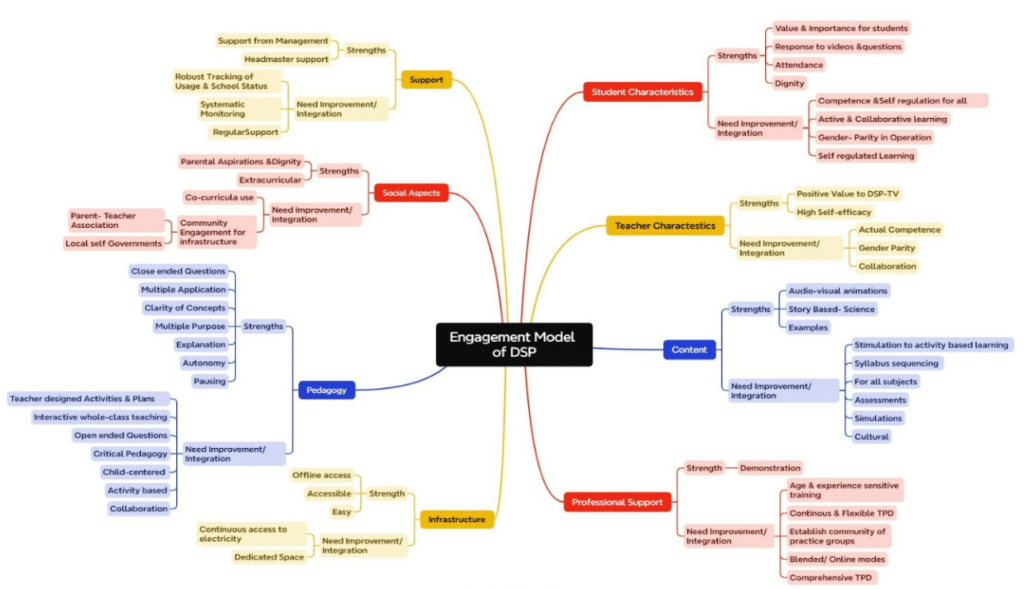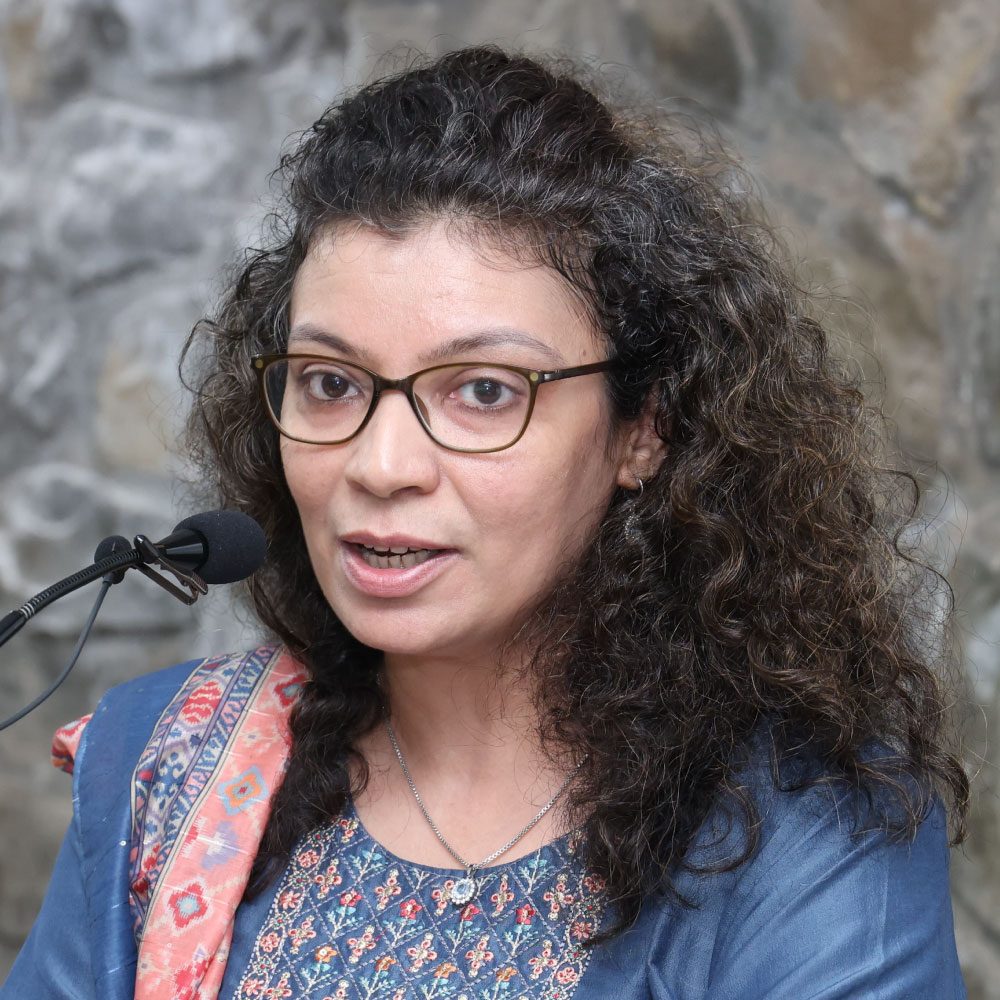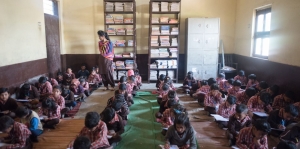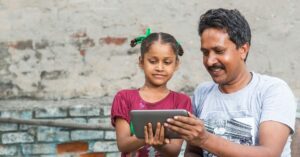A recent research report, Studying Engagement with Digital Classrooms in Upper Primary and Secondary Government Schools across Madhya Pradesh, examines how technology is integrated into government schools. Led by Prof. Amina Charania and commissioned by CSF, the two-year study from 2023-2025 focuses on schools implementing an NGO-led Digital Shaala Programme (DSP) in two districts of Madhya Pradesh (Indore and Gwalior). It explores smart classroom adoption, challenges and conditions for effective technology-driven learning. In this interview, Prof. Charania shares key insights and lessons for the future of EdTech in India’s government schools.
1. What were the primary objectives of your study on digital classrooms in Madhya Pradesh and how do the findings challenge or validate current perspectives on the role of technology in education?
The literature on smart classrooms highlights four key components: smart multimedia content, interactive engagement, smart assessment and an enabling physical environment. Our study focused specifically on multimedia-enabled e-content (MME) delivered through smart TVs, examining its influence on pedagogy and learning engagement. This research was conducted within the Digital Shaala Programme, where an NGO provided Smart TVs pre-loaded with high-quality e-content videos designed to enhance student engagement in government schools.
We examined the value and challenges that teachers and students associated with MME and the nature of teaching and learning engagement for Math and Science in upper primary and secondary grades of government schools in Madhya Pradesh. The study aimed to uncover practical insights around actual usage, teacher preparedness and conditions that enable or hinder effective integration of digital tools in classrooms.
While technology is often seen as a means to improve learning, findings from studies like Avanti–J-PAL study caution against over-reliance. The study revealed a ‘productivity paradox’, where the mere introduction of technology does not guarantee better outcomes and may even disrupt pedagogy, if not carefully integrated and might have negative impacts on learning. Conversely, Gujarat’s Gyankunj Project has demonstrated that structured implementation and strong teacher engagement can lead to improved learning in digital classrooms. These perspectives reinforce the need for contextual research like ours, which explores how to drive meaningful adoption and integration of smart classroom technology within the school ecosystem.
2. What key challenges did you identify in implementing smart classrooms in government schools? What steps can be taken to overcome these obstacles to enhance the effectiveness of digital classrooms?
One of the major challenges in implementing smart classrooms was inadequate infrastructure — frequent electricity shortages, lack of equipment safety and poor maintenance significantly limited the sustained use of multimedia-enabled e-content. Teachers also faced limited training and ongoing support, which affected their confidence and ability to integrate technology effectively. Additionally, both teachers and students — particularly those with longer exposure to smart classrooms, expressed the need for more diverse and regularly updated video content to maintain engagement and relevance.
To address these challenges, schools must seek support from the state administration and local communities to ensure stable electricity, secure infrastructure and routine maintenance. For training, moving beyond one-time demonstrations to using a specific digital tool is essential; instead, programmes should equip teachers with pedagogical strategies for diverse technology integration. Experienced teachers can serve as peer mentors, modeling effective MME usage in real classrooms. Building communities of practice where teachers can exchange lesson plans and share best practices will also foster collaborative learning. Finally, investing in a user-friendly platform will empower teachers to design, share and access lesson resources with ease, driving more effective and sustainable use of digital tools in classrooms.
3. How important is teacher training and continuous support in the integration of smart classrooms? What strategies should be put in place to ensure that teachers are effectively prepared to use these technologies in the classroom?
The study revealed that teachers received limited training, primarily demonstrations focused on operating the DSP infrastructure and using MME (TicTacLearn) videos, rather than integrating them meaningfully into pedagogy. The findings also show that teachers used a directive pedagogy (traditional teacher-centred teaching style where teacher transmits knowledge/content and students passively receive the information), with minimal interaction or closed-ended questions. However, teachers demonstrated initiative — sourcing additional YouTube videos and expanding the range of multimedia-enabled e-content used in their classrooms. While younger teachers reported greater digital comfort, older and more experienced teachers were also observed effectively using MME through structured activities.
To support effective smart classroom integration, the study recommends continuous professional development that moves beyond basic tool usage. Teachers should undergo practice-based training in interactional-directive pedagogies suited for one-to-many teacher-led digital instruction. This training should expose them to a range of pedagogical approaches — including directive, interactional and constructivist strategies — while equipping them to integrate diverse digital resources meaningfully. Flexible and ongoing training, supported by professional learning networks, is essential. Additionally, establishing career pathways and offering incentives for expert teachers to mentor their peers can further build teacher capacity. Together, these efforts will strengthen digital confidence, enhance subject-specific pedagogical skills and enable teachers to deliver engaging, student-centered learning using technology
4. From the study’s findings, what are the most essential elements that need to be in place for smart classrooms to create impactful learning experiences in government schools. How can these elements be scaled?
Apart from a reliable infrastructure, to ensure that smart classrooms create meaningful learning experiences in government schools, certain non-negotiables must be in place:
- Teacher Agency: teachers must have knowledge, competence, and autonomy to use digital technologies and pedagogies suited to their learners and contexts. There also needs to be accountability for efficient use of digital technologies and resources for inclusive and active teaching and learning.
- Pedagogical Support: teachers require continuous technical and pedagogical training and support to effectively integrate technology in classrooms
- Updated MME Content: content must be diverse, blended with active and immersive pedagogies- including reflection prompts and thought-provoking activities for students.
Findings from the study highlight that despite infrastructure and safety issues particularly in rural areas — more rural schools than urban ones continued to use the programme. Nearly 50% of schools that had discontinued ground support were still actively using MME and DSP infrastructure. This suggests that while access to infrastructure and support is important, the perceived value and aspirations associated with digital technologies often outweigh logistical barriers.
Some of the benefits related to MME included the simplicity and ease of use of the device and software to drive clarity in students’ understanding of curriculum concepts and provided flexibility to teaching — whether for introducing a topic, revising content, or filling in during teacher absences. School leaders also acknowledged how smart classrooms brought a sense of parity and dignity to government schools, making them feel comparable to the resources available in private institutions.
The study also surfaced gender-based disparities in the MME usage by students and teachers, reinforcing the need to embed inclusive practices and critical pedagogy within digital education efforts.
5. Looking towards the future, how can the insights from this research inform the development and implementation of EdTech programmes in India, particularly in schools with limited resources?
Looking ahead, the insights from this study offer key strategies for designing, scaling and sustaining EdTech programmes, especially in resource-constrained government schools:
- Keep Digital Tools Simple and Adaptive: classroom technologies should be easy to use, flexible and compatible for integration with a variety of diverse teaching methodologies to ensure widespread and consistent usage.
- Build Teacher Capacity: ongoing training and mentorship are essential to enable teachers to confidently integrate digital tools to enhance academic and socio-emotional learning outcomes.
- Prioritise Sustainable Implementation: instead of focusing solely on device procurement, it is critical to allocate dedicated budgets for device maintenance, content updates and long-term tech support to ensure continued functionality and relevance.
- Align Digital Content with State Curriculum: ensure that multimedia resources are directly linked to the curriculum to enhance relevance, accessibility and adoption across schools.
- Invest in Research and Scalability: regular studies should be conducted to understand what works, why it works and how EdTech solutions can be made more effective and sustainable.
By focusing on these strategies, EdTech programmes can move beyond one-time interventions to become sustainable solutions — bridging the digital divide and making quality education more equitable and effective for students across India.

The Engagement Model of Digital Shaala Programme (DSP) highlights key strengths and areas for improvement across pedagogy, student-teacher characteristics, content, infrastructure, and support systems. It emphasises interactive learning, teacher competence, systematic monitoring, and community engagement to enhance digital classroom’s sustainability, fostering deeper engagement, tech integration, and improved teaching-learning experience in schools.



